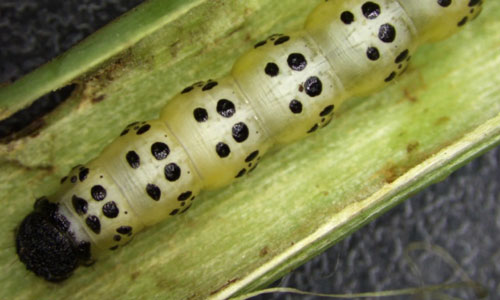Taking an environmentally sensitive approach to pest management
Spindle Worms In Elderberry Shoots
Published: March 27, 2017
Spindle worms, commonly known as the larval stage of the elder shoot borer (Achatodes zeae), will soon be apparent on elderberry plants in Missouri. They will be most noticeable as theyfeed on the tissue inside young elderberry shoots (about six to ten inches-long), causing these stems to bend over and wilt. Because of this feeding damage, these stems fail to flower and produce fruit.

Figure 1: The larval stage of the elder shoot borer (Achatodes zeae) inside a young elderberry shoot. Note the entry hole at the top left side of the plant tissue
The adult stage of the elder shoot borer is a moth that lays eggs in masses in canes at least one year-old usually in July and August. Eggs hatch the following spring. Larvae feed first within the unfolding leaves, with the damage often inconspicuous at this time. However, as the small larva bores into new shoots, a hole in the tissue is visible. When such a stem is dissected, a spindle worm is clearly visible. These larvae have a yellowish-white segmented body with shiny black spots and the head, thoracic and anal shields are also black (Figure 1). Spindle worms feed inside the stems, growing to about 1.5 inches-long at maturity. When larvae are fully grown in early summer, they leave the shoots and tunnel into dead canes to pupate, leaving small piles of frass (sawdust) on the ground at the base of the old wood.
To control Achatodes zeae, prune out infested green shoots or mature canes that have holes in them during the growing season. In winter, remove dead canes to reduce pupation. Always remove prunings from the area or burn them.
A different pest, Desmocerus palliatus, known as the elder borer beetle, also damages elderberry plants. These plain white grubs larvae bore into pencil-sized or older canes, where they feed. Damaged canes wilt, die, and remain on the plants as dangling, necrotic tissue. Adults are iridescent blue with prominent yellow markings and are classified as long-horned beetles (see http://bugguide.net/node/view/14265). Beetles are present during elderberry flowering, where they eat pollen and leaves, and then lay their eggs on leaves or canes near the ground. To control this pest, prune out infested elderberry canes and burn or remove them from the planting.
Subscribe to receive similar articles sent directly to your inbox!
- Spindle Worms In Elderberry Shoots (03/27/17)
REVISED: February 21, 2017